This week on the Naked Scientists we cross hemispheres to explore galaxies far far away. Chris presents live from Johannesburg to discuss the South African Large Telescope whilst back in the studio we explore the effects of space travel on the body, the expansion of our universe and the possibilities of another planet earth. We also investigate effects on our hearing and bring you a special kitchen science that could be out of this world.
In this episode
04:39 - Could “the curse” be a blessing in disguise?
Could “the curse” be a blessing in disguise?
In a slightly icky turn of events, collaborating researchers in the US have discovered that menstrual blood could be a potential source of a new type of stem cells, which can be turned into several different sorts of cells.
Every month, new blood vessels grow in the womb, to prepare for any potential fertilised eggs that might drop in. If a woman doesn't become pregnant, then this lining is shed.
Writing in the journal Science Translational Medicine, the researchers showed that this blood contained stem cells that can be grown in the lab, which can multiply up to 70 times - dividing once every 20 hours. This is much faster than other types of stem cells from the umbilical cord or bone marrow.
These cells, termed Endometrial Regenerative Cells, can be coaxed into at least 9 different fates, including heart, liver and lung.
Just 5 ml of menstrual blood from a healthy woman could provide beating heart cells after two weeks growing in the lab. The researchers think these cells could be grown on a large scale, which would provide an alternative to using bone marrow and umbilical cord blood, which itself poses threats of rejection by the immune system.
And although the technology is still at a very early stage, a company in the States is already offering to freeze and store menstrual blood, in case it becomes a viable treatment in the future. However, it's not clear if these cells could be manipulated in order to treat men, or if they are just for girls.

Ancient chocolate was an offshoot of the beer industry
 A new study out this week has revealed that chocolate was discovered by accident as a by-product of the beer-making process.
A new study out this week has revealed that chocolate was discovered by accident as a by-product of the beer-making process.
Not only that, but archaeologists have also found that chocoholics have been around for at least 3000 years, which is 500 years longer than was previously thought.
It was the central American Indians who first invented chocolate - and it now seems that they might have stumbled on the delicious treat only after they had been making beer for several hundred years from the same plant that chocolate is made of - called cacao.
In this chocolatey study, researchers from several American universities have extracted and identified residues of cacao from the pores of fragments of ancient pottery found in Honduras that date back to the second millennium BC.
Today, we make chocolate from the fermented seed pods cacao, and it was tell-tail traces of a compound found in cacao called theobromine that was found in these pottery shards
But before they made chocolate, people used cacao to brew a type of beer called chica that is still drunk today by tribes in South America.
Ancient makers fermented the cacao seedpods, and used the pulp to make beer from, throwing away the seeds.
The type of pottery container that the ancient cacao residues were found in was the type that beer was served in.
And it was another three hundred years until people started using the discarded fermented seedpods to make a frothy non-alcoholic drink that came to be highly prized even though it must have tasted dreadfully bitter - the forerunner of our modern day chocolate.
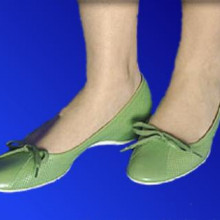
Wrong shoes could be hazardous to your health
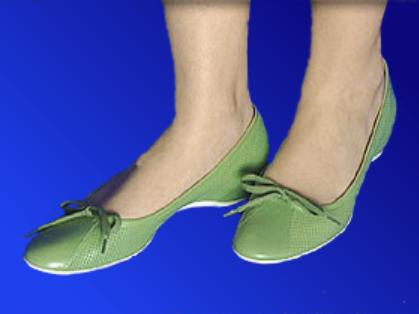 You may think that the only health consequence of badly-fitting shoes could be a few blisters or even a twisted ankle. But now researchers at the University of Dundee have shown that more than six out of ten people with diabetes are walking around in the wrong-sized shoes, potentially leaving themselves vulnerable to serious foot problems that could lead to amputation.
You may think that the only health consequence of badly-fitting shoes could be a few blisters or even a twisted ankle. But now researchers at the University of Dundee have shown that more than six out of ten people with diabetes are walking around in the wrong-sized shoes, potentially leaving themselves vulnerable to serious foot problems that could lead to amputation.
The research is particularly timely as it was World Diabetes day on the 14th of November. In fact theWorld Health Organization has said that the number of people suffering from diabetes could double to 366 million by 2030 and that 80 per cent of diabetic foot amputations could be prevented.
In the study, a hundred people with diabetes, aged 24 to 89, had their feet examined and measured while they were both sitting and standing. The team found that around two-thirds of the patients were wearing the wrong-sized shoes. For example, 45 per cent were wearing the wrong width fitting, with most being too narrow.
This finding is important, because people with diabetes can have problems with a lack of feeling in their feet. And nearly half of the patients in the study had experienced previous problems with their feet, including ulcers, callouses, bunions, corns or swelling. Severe ulcers can lead to amputation, and can be caused by badly-fitting shoes.
The researchers say that foot problems for diabetics could be reduced by adults being offered foot-measuring services in shoe shops. They would also like to see manufacturers developing standardised shoe sizes and expanding the range of length and width fittings that they offer, especially for patients who have no feeling in their feet. The study also raises concerns about patients with conditions like rheumatoid arthritis, which also cause foot problems.
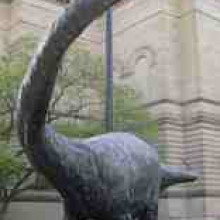
New Dinosaur overlooked for a century
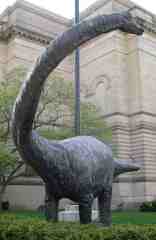 A completely new family of dinosaurs has been discovered at the Natural History Museum in London after a researcher noticed a dusty old fossil that had been sitting on a shelf unnoticed for over a hundred years.
A completely new family of dinosaurs has been discovered at the Natural History Museum in London after a researcher noticed a dusty old fossil that had been sitting on a shelf unnoticed for over a hundred years.
It was PhD student, Mike Taylor, who noticed the fossil and immediately realised he had found something very unusual. Taylor is an expert on the backbones of sauropods - the biggest group of animals ever to walk the earth including diplodocus - they are recognisable with their huge bodies, long long necks and small heads.
The new dinosaur has been named Xenoposeidon - which roughly translates as alien sauropod. It lived around 140 million years ago judging by the size of its back bone, the animal was probably about the size of an African elephant.
The specimen was originally found in the 1890s by a fossil collector called Philip James Rufford who found it in the English county of Sussex. At the time it was briefly described but it wasn't thought to be an especially important find. The reason palaeontologists have now been able to decide this dinosaur did indeed belong to a new family that has never been seen before, is because since its discovery one hundred years ago, over a hundred other sauropods have been named, and we know so much more about them than we did in Rufford's day.
It makes you wonder what else might be lurking unknown in the mysterious vaults of the Natural History Museum.
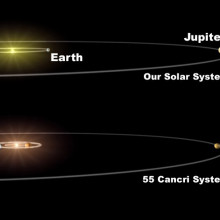
16:09 - An Alien Solar System
An Alien Solar System
with Professor Geoff Marcy, who's from the University of Berkley,
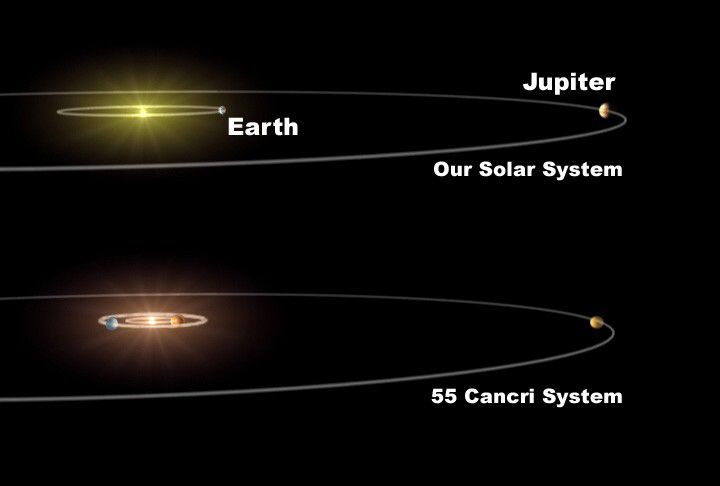 Kat - Now in the news last week was the story around what, essentially, is a very boring star. Now the star is called 55-Cancri; it's 41 light years away; found in the constellation Cancer; and it seems to be very similar to our Sun. To get the full story, earlier this week Ben Valsler met up with Professor Geoff Marcy, who's from the University of Berkley, to find out.
Kat - Now in the news last week was the story around what, essentially, is a very boring star. Now the star is called 55-Cancri; it's 41 light years away; found in the constellation Cancer; and it seems to be very similar to our Sun. To get the full story, earlier this week Ben Valsler met up with Professor Geoff Marcy, who's from the University of Berkley, to find out.
Prof Marcy - Way back in 1989 my team began taking Doppler shift measurements of this rather obscure sunlight star 55-Cancri. Every year we would take a few more Doppler measurements and we didn't see anything for quite a few years. Then around 1996 we noticed that the star was wobbling.
We quickly realized that it was wobbling because a planet was pulling on the star with an orbital period of about 14 days. We were delighted but then we got worried because over the next few years the star didn't behave as if it just had this planet around it. It was wobbling for other reasons that we didn't understand. Soon we realized that there was a second planet.
By the late 90s we actually discovered yet a third planet. Now in 2007 we can see the effects of yet a fourth and even a fifth planet. What's remarkable in hindsight is to notice that over 18 years ago we began observing a star with no sense, no knowledge that there were any planets at all. It's turned out to be a goldmine, this star.
Ben - So how do you go about spotting a planet that's so far away you can't actually see any light reflected off the planet?
Prof Marcy - The sad truth is that even with the Hubble Space Telescope you can point it at a nearby star and any planet that might be orbiting that star would be lost in the glare of the host star. So we use a trick. The idea is to watch the star, not the planet and we look to see if the star is stationary, which as Newton said, it would stay unless it's acted upon by an outside force. And in fact, any star orbited by a planet would feel the gravitational tug by the planet, acting on the star, causing the star to wobble. We watch star to see if they're stationary or if they move. We do that by measuring the Doppler effect that all of us are familiar with. When you hear a train whistle go by the pitch changes and so it is with star light. The frequency of the light waves change as a star wobbles in space. We measure that and thereby detect the planets.
Ben - So you're looking for a signature of a planet rather than the planet itself? How to you tease out which wobbles are caused by which planet?
Prof Marcy - A star that's orbited by just one planet in the simplest case will execute a small circular motion as the star is yanked on by the planet. If there are two planets there, you'll see the star execute a curlicue pattern, sort of circular motion superimposed on a larger circular motion. And so we have to pull the planets apart one by one from the motion of the star and eventually we're able to detect all five planets. Not unlike your ear hearing five notes on the piano. Eventually, of course, you can tell there's not just one or two notes but a full five notes.
Ben - What is special about the star 55-Cancri?
Prof Marcy - What's lovely about 55-Cancri is that it's a Sun-like star. It has nearly the same mass as the Sun - even the same age of about 5 billion years and nearly the same chemical composition. In fact 55-Cancri's a little richer in the heavier elements like oxygen, silicon and iron. Soit's a Sun-like star. Of course, what's wonderful about our solar system is that there are eight major planets orbiting it and now we have 55-Cancri with its five planets that we've so far been able to detect. It may well be that there are smaller planets orbiting 55-Cancri, Earth-like planets that our technology can't at present detect at all.
Ben - Four of the five planets are what we would think of as being as gas giants. So why do you think that there's a likelihood that we'll find rocky or Earth-like planets?
Prof Marcy - It's amazing that this 55-Cancri system has four gas giants.The innermost planet, the fifth one, being smaller (about 13 Earth masses).There's a gap between planets four and five, a large gap, within which we detect nothing at all. Without the ability to detect Earths it could well be that there are rocky planets in there: Mars-, Venus-like or Earth-like planets. They may in fact be warmed up to nearly lukewarm temperature with a little greenhouse effect added in. So that gap offers an opportunity for us to go with next generation equipment and try to detect any Earth-like planets that may be there.
Ben - So what is the next step for you?
Prof Marcy - Well, there are several exciting next steps. The Europeans and Americans are trying to work together on a spectacular new telescope called Darwin/TPF (the Terrestrial Planet Finder). The idea of Darwin and TPF isto take the first pictures of an Earth-like planet. I think it would bemarvellous, some day, to open up the newspaper and see above the fold ayellow dot, the host star, with a small pale blue dot orbiting that yellow star. For the first time we would know that there are other Earths out there in the universe.
How long could life continue without the sun?
That's an excellent question and I think the answer will surprise you because I would be willing to put money on it being millions, if not billions of years. The reason I say that is because there was an answer to this question, sort of, provided not far away from where I am in South Africa - In a goldmine not far away from Johannesburg. About a year ago, Lisa Pratt who's a researcher in the US published a paper in the journal Science where she and her team had isolated some bacteria from 3km underground down a mine shaft. Water that was accompanying these bacteria, coming out of a hole from the side of this mineshaft was analysed and found to be between 16 and 40 million years old. In other words that water had been cut off from the rest of the Earth for up to 40 million years. When they cultured it, it was thriving with bacteria. So those bacteria themselves must also have been cut off from the rest of the world. So what were they eating in water, 3km underground in temperatures of 70 degrees centigrade? Analysis of how these bacteria survived suggests that what they're actually doing is living off radiation which is coming out of the rocks. There's a lot of uranium in the rock. Uranium spits out alpha particles, it has a helium nucleus, the alpha particle is radioactive and hits water particles. When it hits the water molecule it breaks it up into what's called a hydroxyl radical. The hydroxyl radical can jump into the nearby iron pyrites (fool's gold) which is in the rock and it breaks up the iron and the sulphur (iron sulphide) and turns it into a form of sulphur that these bacteria can metabolise. As a result these bacteria can grow and then feed other bacteria which are also present in there. My guess is that if the Sun suddenly went out, although all life that's dependent on the Sun would cease to exist or would probably die pretty fast, there would certainly be bacteria like these that can survive on other sources of energy such as radiation or those that survive around hydrothermal vents at the bottom of the sea.
I think we'd probably be stuffed. One little comfort is that, in fact, the light that's coming out of the Sun is already at least one million years old by the time it gets to us because it's been bounced around like a pinball inside the Sun before it escapes. Even if the Sun's nuclear reactor went off, for some reason, tomorrow you'd still have a million years' worth of light stored up inside.
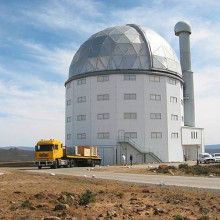
25:17 - Southern African Large Telescope
Southern African Large Telescope
with Case Rijsdijk
Chris - I'm down here in Johannesburg, South Africa, joining you live from the southern hemisphere where scientists are putting together what could amount to a very, very powerful telescope indeed. To tell me more about it is Case Rijsdijk. He's from the South Africa Astronomical Observatory and is going to be part of SALT (the Southern African Large Telescope array). Case, what, actually is this telescope and how will it work?
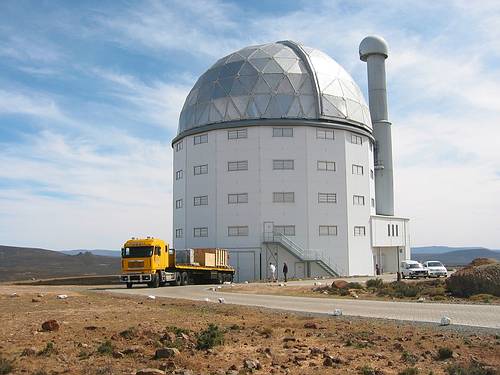 Case - Well, it's a design very similar to one built in Texas, called the Hobby Eberly telescope which we're using as a prototype. Of course, we have to accept the changes in design and so on. But it's now been completed. The ground base was in 2000, and on the 1st of September 2005 we had the first images, the first light. We've had a couple of teething problems but the telescope is functioning well. It is, of course, an enormous undertaking to build such a complex piece of machinery. Many countries didn't believe we were capable of doing it but we proved them wrong. We've actually got a better telescope than the Americans have and we've got lots of partners from all over the world to join us in this vast project.
Case - Well, it's a design very similar to one built in Texas, called the Hobby Eberly telescope which we're using as a prototype. Of course, we have to accept the changes in design and so on. But it's now been completed. The ground base was in 2000, and on the 1st of September 2005 we had the first images, the first light. We've had a couple of teething problems but the telescope is functioning well. It is, of course, an enormous undertaking to build such a complex piece of machinery. Many countries didn't believe we were capable of doing it but we proved them wrong. We've actually got a better telescope than the Americans have and we've got lots of partners from all over the world to join us in this vast project.
Chris - So when you say telescope - is this a telescope in the Isaac Newton/Galileo sense of the word or is it something different?
Case - No, it's very different. This telescope has what you call the Arecibo principle. A primary mirror stays fixed in altitude. It can rotate so we can see 70% of the sky for 20% of the cost. That makes it for us a great compromise for a developing country.
Chris - Light is focused with a mirror onto a detector. How big is that mirror?
Case - The mirror is 11 meters across.
Chris - That's huge!
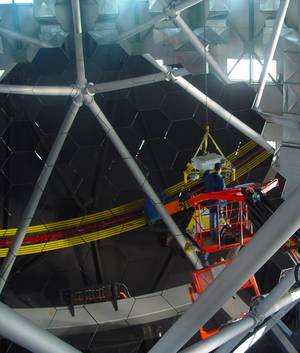 Case - That's huge and the reason why it's not the largest single telescope in the world was quite simply that we don't always use all of that surface. As the telescope is parked, pointing at the object we look at there's a tracker beam at the top that moves across and collects the light. Of course, at some stages you're not looking exactly down the middle, you're looking slightly towards the side which means you're probably looking at an 8 or 9m telescope. Worst case scenario is a 7m telescope, best case scenario about 10.5m.
Case - That's huge and the reason why it's not the largest single telescope in the world was quite simply that we don't always use all of that surface. As the telescope is parked, pointing at the object we look at there's a tracker beam at the top that moves across and collects the light. Of course, at some stages you're not looking exactly down the middle, you're looking slightly towards the side which means you're probably looking at an 8 or 9m telescope. Worst case scenario is a 7m telescope, best case scenario about 10.5m.
Chris - The published literature says you could see a candle flickering on the moons surface with this but obviously you don't want to look at the moon's surface with it. You want to do other things. What can you achieve with it?
Case - Well, because it's got nearly 80 square metres of light collecting surface which is an enormous amount you can in fact do a lot of things which take very short periods of time. You can do time series analysis, rapidly rotating binary stars it's also designed to pick up planets around distant stars. We heard about that earlier on. SALT is ideally designed to do that. With that sort of capacity it can look back very, very far into the universe.
Chris - Why do we need another ground base telescope when we've got things like the Spitzer Space Telescope looking at infrared; we've got the Hubble telescope, on its last legs admittedly, but NASA have got the James Webb planned for 2013 so why do we need a ground base? Aren't there all kinds of problems with the atmosphere corrupting the image?
Case - Yes there is. Of course, we still need the ground base telescopes to do the high- a lot of the equipment that is required to analyse the light needs to be massive. It's tonnes of stuff which you can't put in a space telescope. Quite often nowadays you'll find that telescopes like Keck and VRT in South America, now SALT as well - they will be collaborating with the space telescopes to do more detailed work. Some telescopes, not SALT, can do what we call adaptive optics where they can actually remove, physically remove, the effects of the atmosphere. So for example VRT is South America is producing better images that Hubble even though it is on Earth. These are problems that develop in technology.
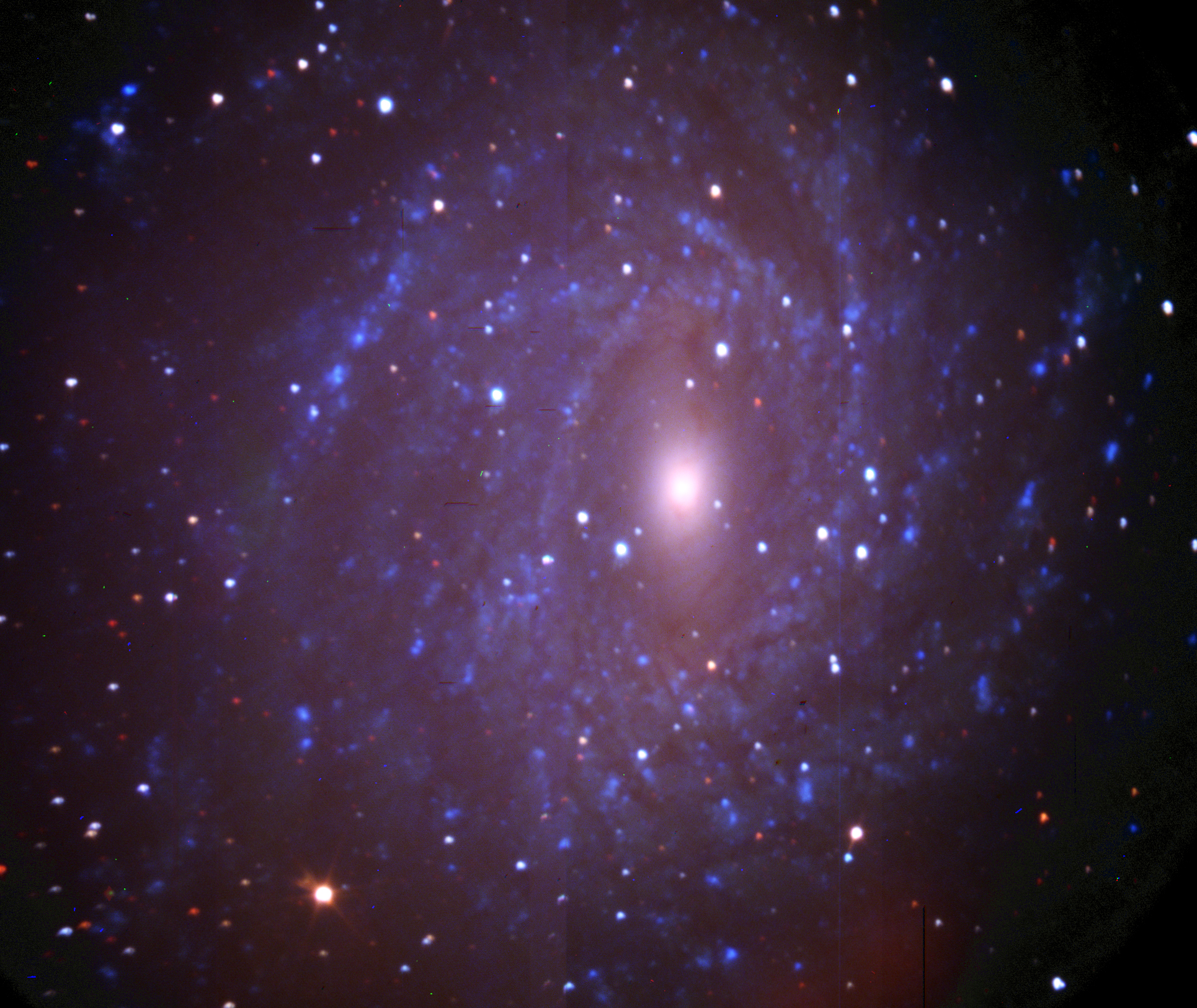 |
| NGC 6744 Galaxy © SALT Foundation |
Chris - Is it fully functional or is there still a sort of work-up going on to get it up to scratch?
Case - We have found that there needs to be a substantial overlap between engineering and science. In America they stop the engineering, started the science and have had problems. We've tried to avoid that and we've got sort of a much longer lead-in chance of doing science. It is doing science, it's producing science and it's already produced some really good results.
Chris - I've got an email here which is from Johann Marsu. He says, 'I love this show, I listen to it while I'm in my cell culture hood,' so I'm guessing he's a cell biologist, 'I've got a question about the Big Bang. Recently I was told we could see the light from the Big Bang. How is this possible? Wouldn't the light from billions of years ago (given the universe is about 13+ billion years old) be absorbed and scattered all over the place by now?'
Case - No. It is possible to look back quite a long way but you cannot look back to the Big Bang. The universe was opaque. It was transparent to neutrinos but not to light. That only came at best 300,000 years after the Big Bang. At present we could probably look back about a billion years and do science there.
Chris - So why is that light still visible? What he's asking is, why hasn't the light become so spread out that we just can't see it?
Case - Well it's - I don't know. We can look back to a supernova with huge red shifts but the light has not been scattered or dispersed. This is a paper by Joe Silk. You can see the supernovae for a very long way back.
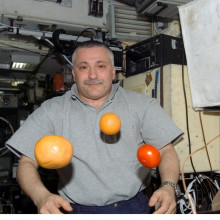
30:57 - Living in space
Living in space
with Kevin Fong
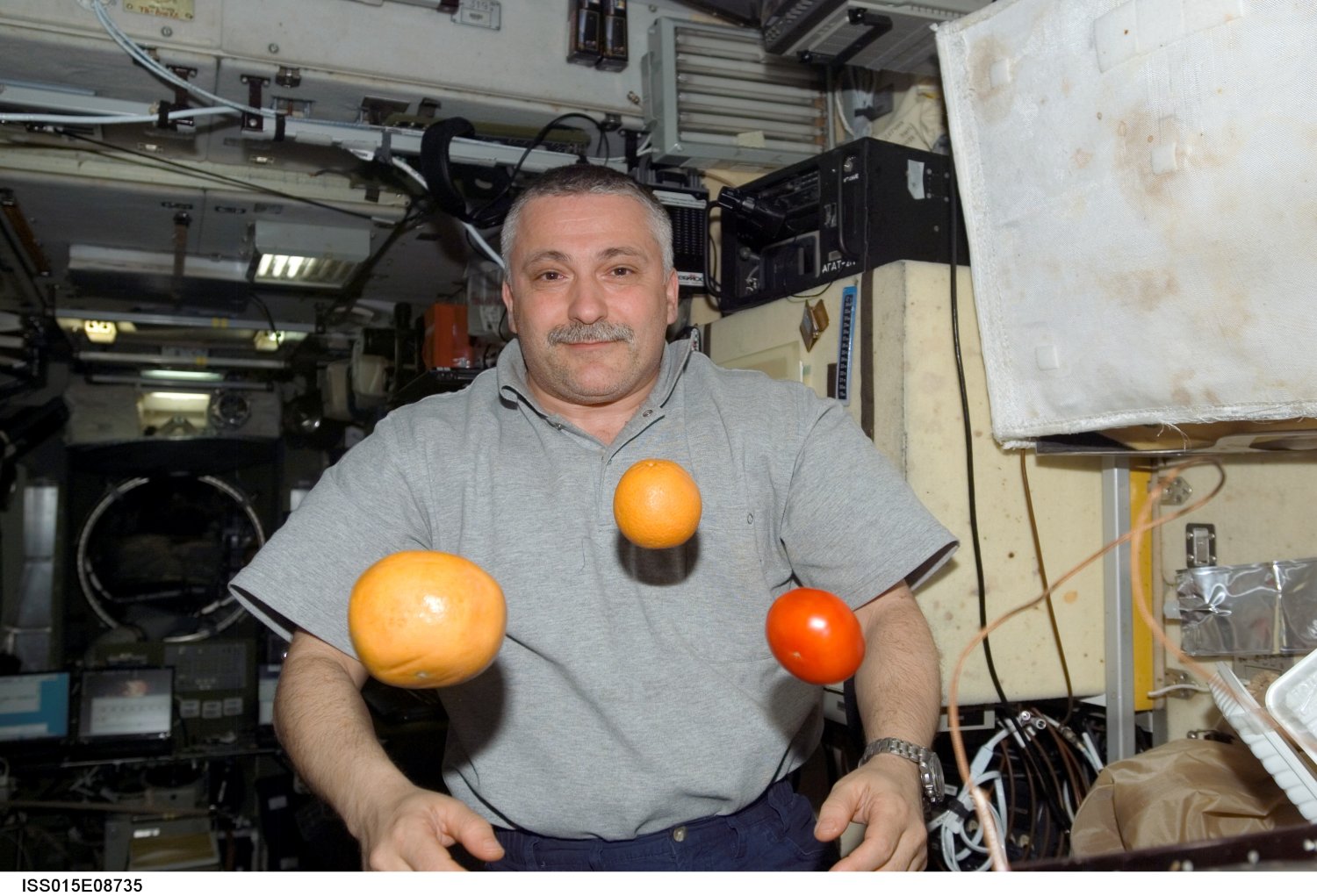 Kat - Now you may think when you watch something like Star Trek, they're all zipping around space in their little space ships and it's all fine travelling to other dimensions - all that. But the reality is very different and space travel has a lot of effects on our bodies. To tell us more about this is Kevin Fong and he's a space physiologist based at University College London. So Kevin, What sort of things actually happen to our bodies when we're travelling in space?
Kat - Now you may think when you watch something like Star Trek, they're all zipping around space in their little space ships and it's all fine travelling to other dimensions - all that. But the reality is very different and space travel has a lot of effects on our bodies. To tell us more about this is Kevin Fong and he's a space physiologist based at University College London. So Kevin, What sort of things actually happen to our bodies when we're travelling in space?
Kevin - It's much more of an insult to the body than people ordinarily think. Going into space is an expedition like any expedition, going to Everest and then to the South Pole. The two things about space are really radiation and the absence of gravitational loading (microgravity). Because of that your bones waste, your muscles waste, your heart - which is essentially a muscle pump itself - undergoes atrophy. You have problems with your balance and coordination. About 7 out of 10 astronauts spend the first couple of days feeling like they want to throw up. It's not pleasant and you genuinely come back feeling like you've come through a pretty tough expedition at the end.
Kat - Are there any things that astronauts can do to kind of get over this? What sort of things do they do at the moment?
Kevin - They partially solve the problem of the wasting of muscle and bone and the deconditioning of your cardio and vascular system by simply doing exercise.
Kat - They have little treadmills in space?
Kevin - They have treadmills that they strap themselves to with little bungee cords. They do that for a couple of hours - two or three hours - a day on most space station missions. That provides some partial protection. It doesn't do anything for your inner ear or your sense of balance and coordination. It only partially protects you from the effects I just mentioned.
Kat - You mentioned radiation as well. How much of a problem is that?
Kevin - In most of our current missions - the stuff that happens on space shuttle and International Space Station it's not that big of a problem, mainly because that all occurs well within the protective limits of the magnetic field. So far we've had astronauts for the longest mission of 438 days without any sever side-effects from that. I think in the future with longer missions going to the moon, going to Mars, to wherever it may be more of a problem.
Kat - At the moment the limiting factor on space travel really is how our bodies can cope with it rather than the technology, do you think?
Kevin - Very much so. That's the thing about human exploration of space. Humans are, by far and away, the most versatile and adaptable research tools that we have today. That's why we do so much exploring with humans on the Earth. They're also the most fragile link in the chain. Yeah, human biology is really the thing that makes it difficult. We've been throwing stuff at Mars and hitting it well - one in every three times since about the mid 1970s. The thing that's stopped us doing it with people is human biology.
Kat - Do you think if we're going to go on super long trips in space, the stuff of sci-fi, would we have to have babies in space? Do you think that's possible?
Kevin - Haha, well the longest missions that are on the chart at the moment look out at something like the mid 2030s and they talk about going to Mars and having human research out there. There's also a couple of things that also sound pretty sci-fi like putting people onto asteroids which is easier than you would ordinarily imagine.
Kat - Doesn't sound easy to me!
Kevin - In the far flung future given the laws of physics as we know them going beyond our solar system and further, then you're talking about needing to have some sort of sci-fi space colony. That's kind of beyond any immediate technology horizon as far as I can see.
Chris - I was just wondering about body clocks and things because when an astronaut goes into space they're obviously orbiting the Earth faster than the Earth is turning. What does that do to their body clock? Because we normally rely on the Sun and the night to set our body clocks so we don't get jetlagged.
Kevin - That's quite right. Circadian rhythms are really quite affected. My very good friend Dan Tanni is on expedition 16 which is flying at the moment and in the days just before he launched we were talking to him. First of all, they have to shift them. Space station runs on GMT so they have to shift them to the day of the launch so they're actually waking up and going to sleep at the right time. You don't want to have a crew who'd just be flying at 17,000 miles an hour into lower Earth orbit feeling a bit sleepy if it's the wrong side of the day. Once they get up there they get 90 minute light/dark cycles. They see the Sun come up and go down over 90 minutes. It does mess with their sleep patterns. There are many things that tell your body when it should be awake and go to sleep. These things are called zeitgeibers which literally means time givers. These things include when you're eating, what temperature it is. But the most potent one is light and dark itself. On the space shuttle and Space Station that's happening very, very rapidly. This basically boils down to the result that astronauts take tranquilisers like they're going out of fashion. They need a lot of help going to sleep.
Chris - Sounds like journalists and people who present radio programs to me! Wrong hemisphere to me.
Is artificial gravity possible?
Gravity is a fascinating subject. It's such a simply observed phenomenon that we have every day if we drop the dishes. We watch it every day in action. For something that's so ubiquitous in our experience yet so poorly understood. I guess the answer to that question is, as far as I can see in anything, away from a machine that you can press an on button and suddenly hey presto you've got gravity. However, you can create gravitational loading just simply by spinning a vehicle up and having a rotating vehicle.
This is not a new idea. Herman Oberth was thinking about it in 1923. Artificial gravity and some of the stuff which I've been working on in Houston at the Space Centre involves just rotating vehicles. There's really nothing more than that trick you pull off when you have a bucket full of water on the end of a rope and you spin it round your head and the water stays in the bucket. I very much think that the future of space exploration will include, at some point, that sort of vehicle.
Is radiation more or less of a problem in deep space?
I wouldn't say less. Eventually you get out into interstellar space and there things would be fairly constant. The effect there would be minimal. They would stay minimal until you approached a stellar system ofsome sort. It's Pioneer 10/11 and Viking 1 and 2 that would have some answers if the data's available.
Although some researchers have suggested that it would be better to go to Mars during a period of solar maximum when the sun is producing the most radiation, because then the sun has the strongest magnetic field which shields the solar system from very high energy galactic cosmic rays which would be impossible to shield against on your spaceship.
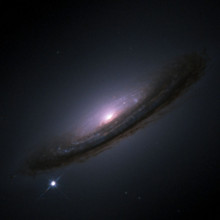
39:35 - The Accelerating Universe
The Accelerating Universe
with Brian Schmidt
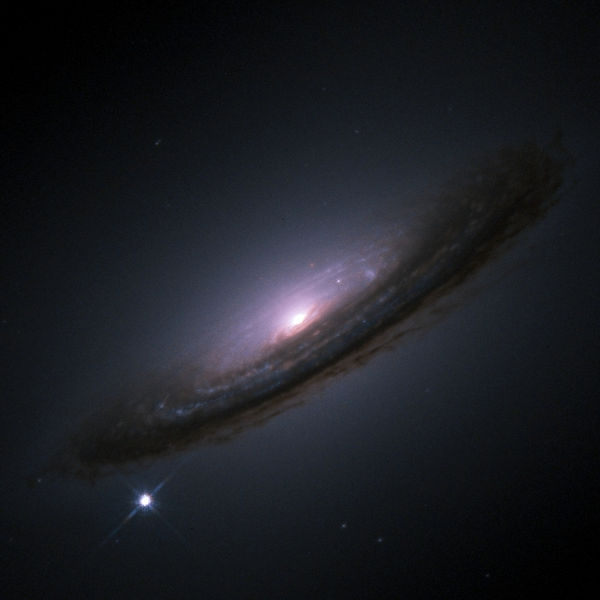 Helen - When Chris is not swanning around South Africa, he's also attending parties with award winning scientists so life isn't that bad. This is how he managed to meet up with Brian Schmidt - one of the winners of the Gruber Cosmology prize. Brian won a share of the five hundred thousand dollar prize for his discovery that the universe is expanding as it ages and the older it gets, the faster it expands.
Helen - When Chris is not swanning around South Africa, he's also attending parties with award winning scientists so life isn't that bad. This is how he managed to meet up with Brian Schmidt - one of the winners of the Gruber Cosmology prize. Brian won a share of the five hundred thousand dollar prize for his discovery that the universe is expanding as it ages and the older it gets, the faster it expands.
Brian - My name is Brian Schmidt and I'm an astronomer at the Australian National University. When we started in 1994 we were trying to literally weigh the universe by seeing how gravity would tug on the universe as it expands. We knew the universe was expanding since 1929 when Edwin Hubble saw that galaxies were moving away from us. The further away they were the faster they're moving away from us.
Just like points on a balloon: if you blow a balloon up you'll see every point moves away from every other point and the further away the two points are, the faster they move apart as you blow that balloon up. So our idea was to go through and track distances back in time because when we looked at really fain things in the universe we're actually seeing light that was emitted 4-8, maybe even 11 or 12 billion years in the past. Using the fact that light takes a while to travel through the cosmos we're able to look back in time and see how fast the universe was expanding four billion years ago compared to how fast it's expanding now.
Chris - When you do this, where does the light that you're studying come from?
Brian - In our case we decided to look at the light of something which we call supernovae which are exploding stars. The nice thing about these exploding stars is they're very bright but they're almost all the same brightness. They're like hundred Watt lightbulbs except they have a lot more 000s behind them than a hundred. They've about 45 or 46 zeroes behind them. By looking at these things we can measure their distance and it takes their light four billion years to reach us.
Chris - How far have you been able to wind back your cosmic clock?
Brian - The most distant object discovered to date is about 11 billion years in the past so we think that is about 2.5 billion years after the Big Bang. This star exploded and its light's been taking the next 11 billion years of the universe to get to us. That object exploded five or six billion years before the Earth was formed.
Chris - How does that tell you how the universe is behaving today?
Brian - We measure how fast the universe is expanding by comparing distances with how fast the universe has stretched between the two times. We measure stretch by how the wavelength of light changes colour. As the universe stretches it takes light and makes it gradually redder and redder. We do that in the nearby universe with lots of objects that are tens of millions of light years in the distance.or even hundreds. Then we do these ones at billions and we compare. We see when we do that the universe is expanding slower in the past and has been speeding up over time.
Chris - So if it is getting faster, why should that be? What's driving it to expand faster and faster as time goes on?
Brian - When we started this experiment we were expecting to measure how fast the universe was slowing down to weigh it. When we found that it was speeding up it was a big surprise and you have to invent something new. The best thing that's ever been invented is something that Albert Einstein invented in 1917, which we call the Cosmological Constant. It is energy that is tied to space itself and so as the universe expands more and more space is created. As that space is created it has energy associated with it. It turns out that type of energy pushes on the universe rather than pulling on it. The acceleration is cause by 75% of the universe right now, being made up of this stuff, hard space.
Chris - So if the universe is getting faster and faster - what does that mean in the long term? I mean in the really long term?
Brian - It would seem that as the universe is speeding up it's going to get faster and faster. It really is speeding up so that in 30 and 40 billion years (so not the near future) light that is getting to us from nearby will actually be stranded by the accelerating universe. Photons will no longer be able to get to us. We're going to look out onto a universe that looks empty to us. All the galaxies we see today and we see literally trillions of them will disappear from view. All we'll see are the galaxies that are right around our own and we'll have all merged into some big super galaxy.
Chris - Is this a stable thing, can it just keep getting faster and faster or will it eventually just snap?
Brian - Well, that's the big question. We don't know because we don't really understand this dark energy. One of the big things that people around the world are trying to do is see whether the dark energy is created exactly with space. If it's created just as Einstein says and it's tied to space itself then it goes on forever and ever. The universe just keeps going for eons. On the other hand, if it's a little different than that then it might be that the expansion will turn off in the future or maybe it'll speed up even more. You don't know. It's a real question of what this dark energy is and measuring precisely how the universe behaves now so that we can extrapolate into the future.
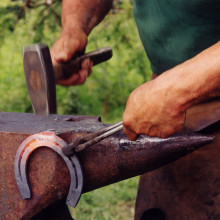
45:44 - Sharp Sounds Damage Hearing?
Sharp Sounds Damage Hearing?
Whenever you listen to sound, the sound actually hits the eardrum. That sound is actually amplified by a series of tiny little bones in the ear called ossicles. These ossicles vibrate and stimulate the float within the cochlear which, in turn converts the sound energy into electrical energy which is perceivedas noise by the brain.There are two different types of noise induced hearing loss. You have acute stage hearing loss, for example due to a large explosion or you may have something more gradual. This is more common in most people. This gradual increase in hearing loss is a combination of both the intensity of the sound as well as the duration of the sound. So for example, someone who shoots guns for a hobby may be exposed to very short bursts of noise but very high intensity and they may experience a similar degree of hearing loss compared to someone who's in a slightly different environment where the sound intensity's actually much lower but much more constant (e.g. the mining industry). There are also additional factors that can influence noise induced hearing loss. It's not just the combination of noise because people's tolerance to noise varies. Therefore there's some genetic influences in this as well. Noise induced hearing loss is not just the simple of noise experienced but also the genes that influence your hearing.
Yujay, ENT registrar at Addenbrooke's Hospital
49:15 - Kitchen Science - Is it a Meteorite?
Kitchen Science - Is it a Meteorite?
Colin - "I was walking back home and I heard this clatter about ten yards away from where I was standing. I thought nothing of it. I walked back home, got in bed and I thought to myself I know what that must be because it can't be anything else. A meteorite."
Meera - That was Colin from Ipswich who sent in a sample of his meteorite to the Naked Scientists. To find out if it really was from out of this world I took it along to the Natural History Museum in London and analysed it with Metoeritics Researcher, Dr Sarah Russell. To start with Sarah told me what the definition of meteorite is.
Sarah - A meteorite is a natural object that originates from beyond the Earth but comes through the atmosphere to land on the ground. Before it lands on the ground it's actually a meteor. When it hits the ground it turns into a meteorite.
Meera - We've got the sample just here now. What do we do first?
Sarah - Well, first I'm going to take it out of this little packet. It looks like an igneous rock. An igneous rock is a rock that's at some point in its history been melted. This is very common for terrestrial rock. But there are some meteorite samples that can also be igneous in texture. It doesn't exclude the possibility it's a meteorite.
Meera - What should we do next?
Sarah - I've got a magnet here. Most meteorites contain some free iron in them and that means they're attracted to a magnet. The first thing I'm going to do is to see if the sample's attracted to the magnet.
Meera - It is actually sticking.
Sarah - yes, it actually is - which surprises me because most igneous rocks are not magnetic.
Meera - There's hope yet?
Sarah - There is hope yet. For this kind of rock I think it's more likely that instead of having iron in it it's got a magnetic mineral in it like magnetite.
Meera - What's magnetite, is that just in a lot of rocks?
Sarah - It's in quite a lot of igneous rocks. It's an oxide of iron.
Meera - We've now found out there is some magnetism in it. Is the next stage to look at it under the microscope?
Sarah - Yes! Exactly. I've got a microscope here so I'll put it underneath.
Meera - the microscope's actually hooked up to a camera here so I can see the sample on the computer screen. What can we see here Sarah?
Sarah - It's not looking good. It's got some dark minerals which might be magnetite. The texture of this looks slightly sugary. This confirms my suspicion that it's an igneous rock. It's got white crystal there. That'sprobably quartz and that's quite an unfortunate result for a meteorite.
Quartz is a very common rock on Earth but it's essentially absent in meteorites. To make quartz you actually have to have a rock that's come from a big planet that's spent billions of years evolving and producing different kinds of rocks. It's not found in asteroids and asteroids are the most common source of meteorites.
Meera - Could the presence of quartz have burst Colin's bubble? Here's Sarah's verdict:
Sarah - I think this isn't a meteorite. I hate to be the bearer of bad news but I don't think this is a meteorite.
Meera - Even though the sample didn't turn out to be a meteorite I asked Sarah what she would have done next if the rock had looked promising under the microscope.
Sarah - If we looked at the rock and we saw that it was a mineralogy that was compatible with a type of meteorite then the first thing that I would do is to get a very thing slice of it called a thin section. We'd use the thin section to look in the electron microscope to look in detail at the composition of the minerals. There are some indicators, for example in meteorites if there is free iron it nearly always has nickel associated with it and that's not true of terrestrial rocks. That's one simple test you can do once you've got this thin section of material. The other diagnostic test is oxygen isotopes because the oxygen isotope composition of most extraterrestrial material is quite different to that of Earth. We can do an oxygen isotope analysis on that and it can tell us for sure whether it originated on Earth or not.
Meera - To show me what real meteorites look like, Sarah took out some samples from the Museum's collection.
Sarah - I wanted to show you this meteorite here which is a meteorite called a chondrite which is by far the most common meteorite that is seen to fall. The first thing to notice when you pick it up it's actually denser than you would expect a terrestrial rock to be. That's because it contains a lot of iron metal in it. Iron metals tend to be denser than rock. Also if you look on the outside you can see it's covered in this very thin dark black layer.
That's called a fusion crust and that formed as the meteorite came through the atmosphere, the outside melted. The fusion crust is really the best diagnostic thing to say if it's a meteorite.
Meera - What are the main types of meteorite that you get here at the Natural History Museum?
Sarah - This meteorite, called a chondrite, is so-called because it contains - I don't know if you can see - it's got some rounded blobs in it. A round whitish blob there and a dark blob there. These are called chondrules.
They're made of silicates that actually formed as individual bits of red hot molten rock that were floating round in the solar system. They solidified and it eventually came into the meteorite. There are two other types: iron meteorites which are made mostly of iron and the other one is stony iron which are complex mixtures of rocky material and iron material.
Meera - So there are three types of meteorite out there to be discovered. Unfortunately Colin's sample showed the presence of minerals formed only on Earth. That doesn't need to stop us from keeping an eye out for meteorites in the future - especially if the source of these space rocks can range from debris dating back to before a solar system was formed to fragments from the surfaces of other planets when those planets were hit by even bigger meteorites. The information they can provide us about our solar system is endless. That's it for Kitchen Science this week. If you want to know more about meteorites then go along to the Natural History Museum at the end of the month as they're launching their new permanent mineral gallery, The Vault, on the 28th of November.
Can we see black holes from the Earth?
Yes, we can but not directly. We can see the effect they have.Basically a black hole is a star that's died, that's collapsed. Unbeknownstto many people many stars are in fact double stars or binaries. The deadstar, the collapsed star can form a black hole. The gravitational fieldsare intense. It sucks material from its companion star and forms what wecall an accretion disc around it. The accretion disc emits x-rays and weknow of many stars that are x-ray stars and these are black holes.
- Previous Science in South Africa Special
- Next Naked Science Q & A Show









Comments
Add a comment